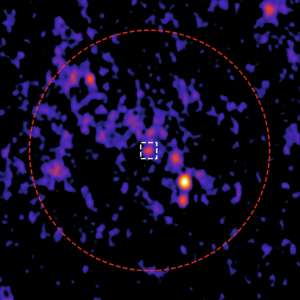A PREVIOUSLY undiscovered radio signal has been detected emanating from an ancient star cluster.
It comes from the centre of the second brightest globular cluster in the night sky – known as 47 Tucanae.
A research team, led by Curtin University members of the International Centre for Radio Astronomy Research (ICRAR) in Australia, has also produced the most sensitive radio image ever of an ancient star cluster.
Astronomer Dr Arash Bahramian says star clusters are an ancient relic of the early Universe.
He said: “Globular clusters are very old, giant balls of stars that we see around the Milky Way.
“They’re incredibly dense, with tens of thousands to millions of stars packed together in a sphere.
Read more about space
“Our image is of 47 Tucanae, one of the most massive globular clusters in the galaxy.
“It has over a million stars and a very bright, very dense core.”
Dr Bahramian said the ultra-sensitive image was created from more than 450 hours of observations on CSIRO’s Australia Telescope Compact Array (ATCA).
It is the deepest, most sensitive radio image ever compiled by any Australian radio telescope.
Most read in Tech
Dr Bahramian said 47 Tucanae can be seen with the naked eye and was first catalogued in the 1700s.
But he said imaging it in such great detail allowed astronomers to discover an incredibly faint radio signal at the centre of the cluster that had not been detected before.
Lead author Dr Alessandro Paduano says the detection of the signal was an “exciting” discovery and could be attributed to one of two possibilities.
Dr Paduano said: “The first is that 47 Tucanae could contain a black hole with a mass somewhere between the supermassive black holes found in the centres of galaxies and the stellar black holes created by collapsed stars.
“While intermediate-mass black holes are thought to exist in globular clusters, there hasn’t been a clear detection of one yet.
“If this signal turns out to be a black hole, it would be a highly significant discovery and the first ever radio detection of one inside a cluster.”
He says the second possible source of the signal is a pulsar—a rotating neutron star that emits radio waves.
Dr Paduano added: “A pulsar this close to a cluster centre is also a scientifically interesting discovery, as it could be used to search for a central black hole that is yet to be detected.”
Co-author Dr Tim Galvin, a research scientist with CSIRO, said: “This project has stretched our software to its limits, in terms of both data management and processing, and it has been really exciting to see the wealth of science that these techniques have enabled.”
He added: “Alessandro’s research represents a culmination of years of research and technological advancements, and ATCA’s ultra-deep image of 47 Tucanae represents just the beginning of the discoveries that are yet to come.”
Dr Galvin said the ultra-sensitive image produced is what researchers can expect from the SKA radio telescopes, currently being built in Australia and South Africa by the SKA Observatory (SKAO).
READ MORE SUN STORIES
Once complete, the SKA telescopes will be the two largest radio telescope arrays in the world, transforming our understanding of the Universe and tackling some of the most fundamental scientific questions of our time.
The research was published in The Astrophysical Journal.
Find out more about science
Want to know more about the weird and wonderful world of science? From the Moon to the human body, we have you covered…










